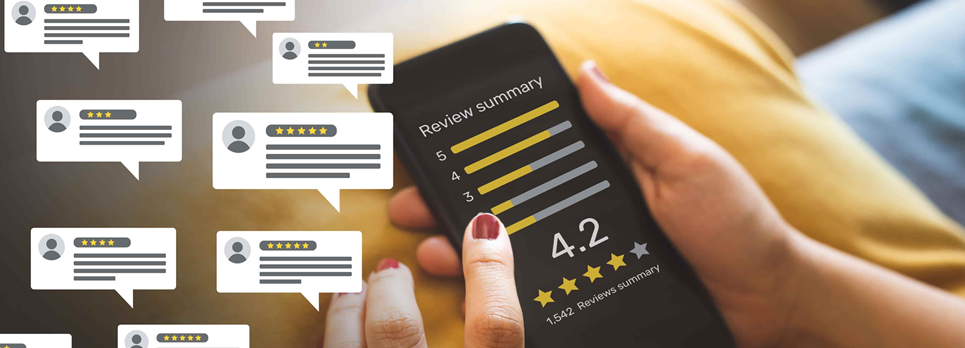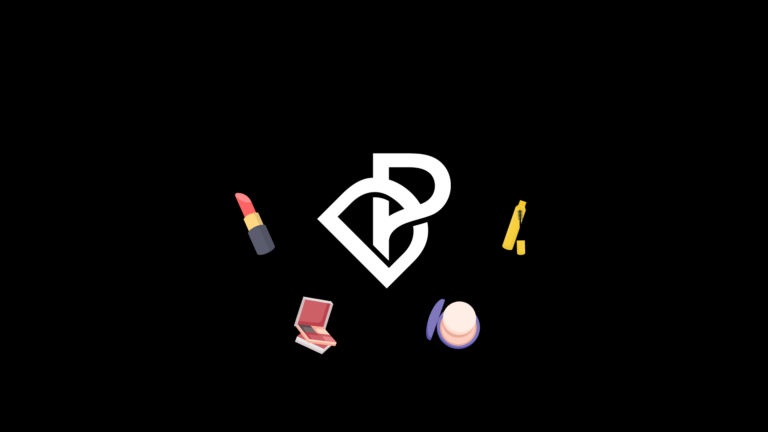KOC marketing in China is gaining popularity due to the rise of big data platforms and new demands from young consumers. Chinese KOCs (Key Opinion Consumers), are regular consumers who love to share their true product reviews on popular social media. Although most KOCs don’t have a large fan base, they are the key for consumers to make a buying decision. One of the main differences from KOLs is KOCs typically have no more than a few hundred fans on social media. However, as everyday shoppers themselves, they are more relatable to their followers. Hence, they are generally seen as more trustworthy due to their authentic and reliable content.
The KOC loop
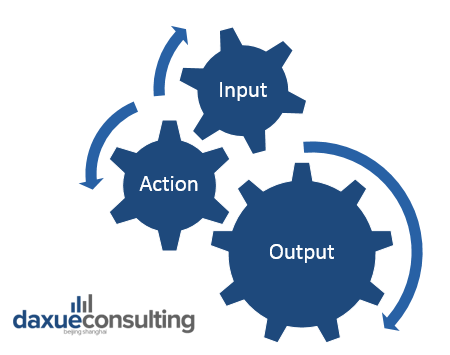
Source: Parklu, daxue consulting design, the KOC loop
The KOC loop includes three stages. First of all, as an “input”, a customer purchases a product based on a KOC’s recommendations. Secondly, a customer makes an “action” to promotes product due to satisfaction, brand reward mechanism or other reinforcements. Then, as an “output”, a customer becomes a KOC after advocating the brand to potential customers.
KOC vs KOL marketing: what to choose?
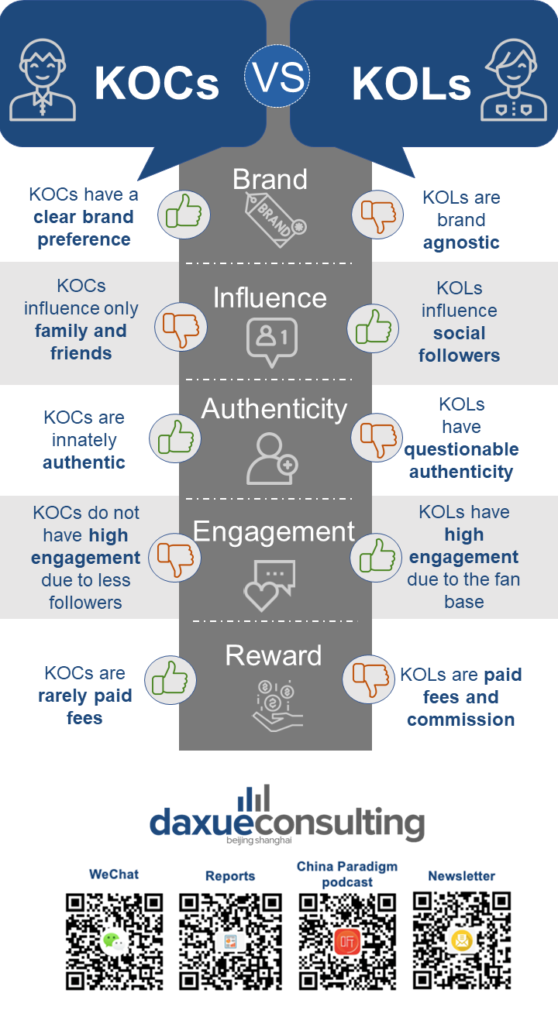
As mentioned, the main difference between KOLs and KOCs is in the number of their followers. KOLs in China have huge fan bases which, however, could mean they do not always have total trust from their audience. Chinese consumers have become more sophisticated and they know brands pay KOLs to do reviews. Moreover, due to a few cases of influencer scandals, Chinese consumers crave more content that is not commercially influenced.
KOCs are a part of word-of-mouth, they help brands to build up their credibility. The fact of using KOCs – together with KOLs – is part of the basic communication strategies in China nowadays, especially for industries that are customer-centric, such as beauty.
Yuwan Hu, COO at daxue consulting
On the contrary, Chinese KOCs are primarilyconsumers who decide for themselves which product they want to try and review. Even though they don’t have a huge fan base, their voices are more credible and followers refer to their reviews.

Source: Azoya, daxue consulting design, impact of different influencer groups
Advantages of KOC marketing over KOL marketing
Authenticity
KOC marketing in China has some obvious advantages. For example, KOCs are more authentic, they simply share what interests them. In addition to sharing products, they share their daily life more often to fully demonstrate their sense of reality. It helps to build trust for a long time.
From the perspective of users, KOCs themselves are ordinary users, and have a very close relationship with followers. In contrast, KOLs often releases information that users do not trust because of business collaborations.
In terms of behavior, KOCs are usually an active member in the community, and are willing to share brand information. A KOC has a certain cross-layer communication power. They may also join the user community in each brand at the same time to broaden their boundaries. For example, a KOC who loves to travel may also love fitness and fashion, so she shares content across multiple fields.
KOCs are cheaper and life-oriented
From the content point of view, the content released by KOCs is more abundant and life-oriented.
As for pricing, KOCs are much cheaper than KOLs. On average, a KOC costs around 50 to 1500 CNY per social media post. But not all of the available influencer platforms give the brand right to use the content thereafter.
KOL’s pricing depends on the size of the community and the number of fans they can reach. For example, on Weibo, an influencer with a reach of 1-2 million people will cost around 30,000 CNY for one post. On WeChat, for a reach of 50,000 people, the cost can rise up to 40,000 CNY. Making good use of several KOCs can produce a higher return on investment than one KOL.
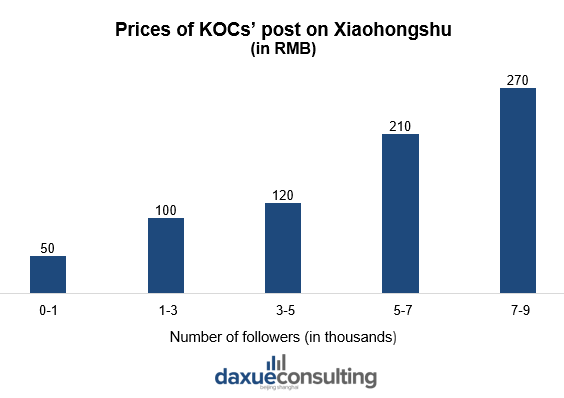
Data source: Chons, daxue consulting analysis, prices of KOCs’ post on Xiaohongshu
KOCs’ disadvantages: how to control KOCs base
However, KOCs in China also have some disadvantages. For instance, it is not easy to control the brand’s advertising effect. It may end up with great efforts, but the marketing effect will not be satisfactory. To solve this problem, the brand should find some agencies to cooperate and then carry out the training and construction of KOCs base.
Organic vs. contrived KOC marketing in China: how to reward KOCs
Organic KOC posts
Not all Chinese KOCs need to get a reward by the brand or will want to join an official KOC program. Motivation for organic KOC can be past satisfaction, post-purchase rationalization, and other emotional and psychological reinforcements. However, there are things a brand can do to increase organic advocacy. For example, actively showing that brand values each customer builds trust and affinity. It’s the tangible human-to-human interactions that make a brand real and increase the chances of customers recommending a brand.
Contrived KOC posts
Some customers will only be motivated by tangible goals and rewards. That’s when brands use incentives to persuade these customers to post. Brands can add advocacy incentives to existing loyalty programs or develop an advocacy program to create a KOC cohort. Launching advocacy focused campaigns like rewarding referrals or group buying can also help to create KOC base. It’s essential to have a range of rewards that can appeal to each potential KOC’s motivation.
What is that like to work with KOCs in China?
Five steps to attract Chinese KOCs
Tong Digital presented a five-step process of “product seeding” to attract Chinese KOCs.
- The process begins with identifying potential KOCs. One way to connect with an audience is by giving them the opportunity to submit reviews. In this way, brand gets the chance to interact with the audience and build a community. After connecting with the audience, brand will most likely collect enough reviews to identify who can stand as a KOC. Consumers with more reviews and creative social media would be ideal KOC candidates.
- Then, brand sends out gifted products to gain the KOC’s loyalty.
- Next, the brand hopes to gather free exposure from KOC reviews.
- After identifying the high-quality KOCs, brand can invite them and digest their feedback to help improve the products.
- Finally, brands should look to formalize KOC partnerships with bigger post-campaign marketing. This low-risk high-reward technique means that brands are only paying out for the product and shipping costs.

Source: Daxue Consulting, the perfect KOC characteristics
KOC marketing in China: targeting Gen Z and millennials
KOC’s popularity is behind the changes in the consumption concept of Generation Z in China. With the rise of Gen Z, promoting goods through KOLs can no longer meet the needs of young customers. Besides, the price of KOLs is too high for many brands. As the internet natives, the consumption concepts of Generation Z have their own unique needs.
The biggest point is that they are no longer sensitive to KOL recommendations. No matter how popular a KOL is, it is hard to make Gen Z buy the product. On the contrary, they are more willing to trust KOCs around them and pay attention to their suggestions. It happens because compared to KOL, KOC’s advice is more real. The entire focus of KOCs is on product reviews, yet often, they only have a few hundred followers on their accounts. For Chinese millennials and Gen Z consumers, this personable, friend-like appeal can have a powerful impact on purchasing decisions.
Where to find KOCs in China?
Big data platforms help brands to find KOCs in China
Many traffic platforms in China such as Kuaishou, Xiaohongshu, DouYu have already bet on KOCs and invested resources in them. A KOC is worthy of refined operation guidance from brand owners to subtly influence consumers. Now, big data analysis has become an important step for many platforms to screen KOCs.
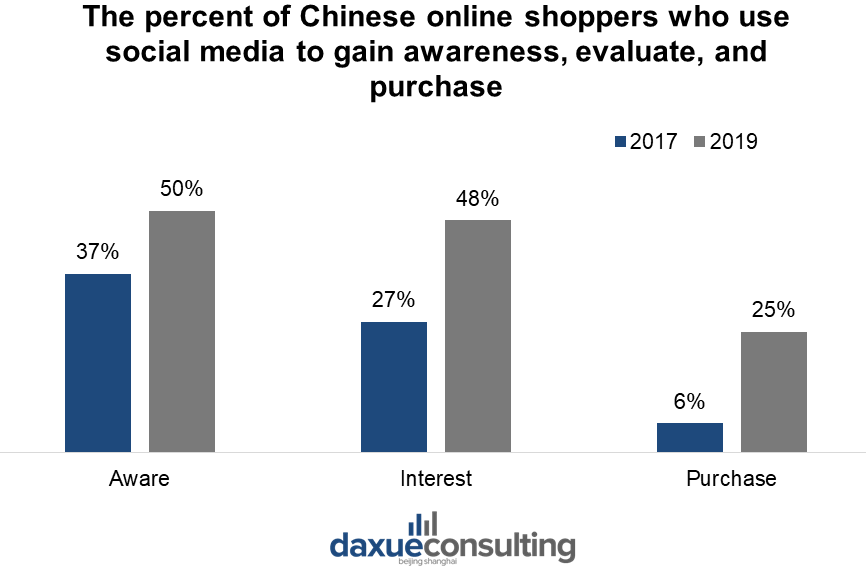
Data Source: McKinsey China Digital Consumer Trends 2019 report, Chinese online shoppers who use social media to gain awareness, evaluate, and purchase
For example, Kuaishou has established various KOC libraries based on its own huge KOC resources. It allows different brands to quickly find KOCs that meet their criteria. In addition, in terms of private domain traffic, Kuaishou uses big data insights to help brands accurately find KOCs, thereby connecting traffic. Kuaishou believes: Trustworthy acquaintance = Trustworthy product. If KOCs have high-quality product promotion, they can have high-quality interactions with users.
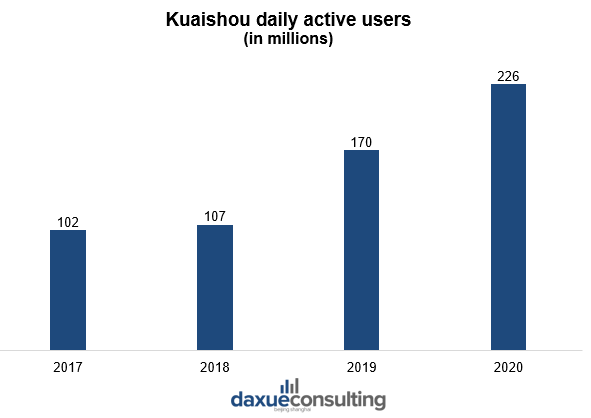
Data Source: QuestMobile, Kuaishou daily active users
In 2019 Kuaishou promoted the sale of shoes with JD.com during the shopping festival. However, some models had high unit prices and users were not ready to pay for it. Kuaishou aggregated the KOCs that shared shoes purchases and did live broadcasts. KOCs shared their opinions on the shoes, how to tie their shoelaces, and how to keep them clean. They have accumulated many loyal fans and greatly promoted sales.
Xiaohongshu: a perfect place for KOC marketing in China
A good platform for KOC marketing in China is Xiaohongshu (Little Red Book). If netizens in China want to learn more about a certain product or explore new ones, it is their go-to-app. KOCs from Xiaohongshu seem credible since they are ordinary people who genuinely want to test a product. Xiaohongshu’s algorithm helps as well since it ranks posts according to the quality, and displays them first in the main feed. Hence, further motivating users of this platform to share their reviews.

Data Source: Statista, Number of Xiaohongshu’s registered users
Peacebird: KOC marketing case study
Peacebird is a fashion retailer targeting Chinese youth, with the mission of “Letting everyone enjoy the fun of fashion”. The company is committed to building core capabilities in omni-channel retail. Peacebird deployed its e-commerce business in 2008, and since developed it rapidly.
In 2019, Double Eleven sales reached 917 million yuan. The company has more than 4,500 physical stores in 31 provinces across the country. In 2019, omni-channel retail sales reached 11.4 billion yuan.
As the coronavirus outbreak hit the retail industry, brands started to pay more attention to the online promotion and marketing. For example, Peacebird mobilized employees to carry out promotions after offline economic shutdowns. During shopping festivals in China, they promoted brand in their social networks. Peacebird also launched the APP “Niaoda” (鸟嗒) to encourage employees and users to share daily wear and to further cultivate and explore potential KOCs.

Source: PC6, Peacebird app Niaoda
Key takeaways for KOC marketing in China
- KOC marketing can be a more authentic approach, as KOCs seem more trustworthy and have closer relationships with their followers.
- The young generation in China tends to listen to KOC’s opinions when choosing a product.
- Chinese KOCs are cheaper than KOLs. Although the reach is not that high, multiple KOCs can be more effective than one KOL.
- Big data platforms in China contribute to the growth of KOCs and help brands expand their KOC base.
Learn about KOL marketing in China
Listen to over 100 China entrepreneur stories on China Paradigms, the China business podcast
Listen to China Paradigm on Apple Podcast



